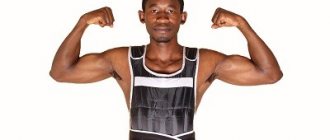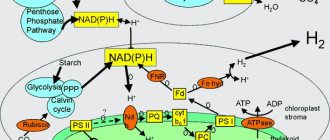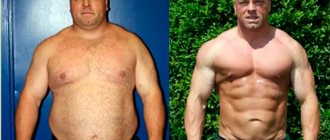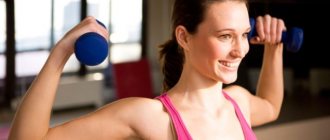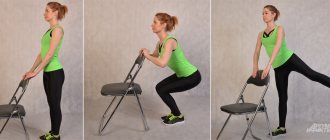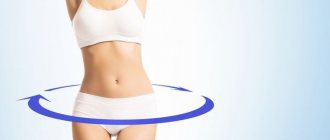Causes of pterygoid scapula
Pterygoid scapula occurs due to weakness of the adductor muscles that bring the shoulder blades together - the trapezius and rhomboid. With one edge they are attached to the spinous processes of the vertebrae, and with the other - to different parts of the bone. The trapezius muscle goes to the top, and the rhomboid muscle goes to the bottom. Under their influence, it approaches the spine and performs movement (rotation) around the sagittal axis.
If the serratus anterior muscle is weakened, then the corners stick out, because muscle fibers are attached to the dorsal and medial part of the bone. The serratus muscle brings the inferior angle to the spine. If this muscle group loses tone or its structure is disrupted, then the scapula takes an abnormal position.
The cause of muscle dysfunction is dysfunction:
- innervation - the dorsal nerve is located close to the surface of the body and its damage leads to pathology;
- blood supply - a violation of transport in the cervical arteries, which ensures the trophic process of tissues, causes the syndrome.
Pterygoid scapula can occur in both childhood and adulthood. Pathology is divided into:
- congenital;
- acquired.
Typically, a birth defect can be noticed immediately after the baby is born. Congenital pterygoid scapula syndrome results from:
- genetic abnormality of connective, nervous or muscle tissue;
- disturbances of intrauterine anlage and development of tissues and organs.
A child can acquire the syndrome as a result of:
- birth trauma;
- poor posture caused by ergonomic furniture (high chair and low table), improper distribution of load (wearing a heavy backpack or bag on one shoulder), improper lighting of the workplace;
- weakness of the muscle corset due to physical inactivity, muscle pathology (atony, dystrophy, hypotrophy);
- spinal or head injuries.
The photo shows how the shoulder blades stick out in a child with scoliosis.
The cause of pterygoid scapula in adults most often lies in:
- injuries, ruptures, muscle strains, dislocation of the shoulder joint;
- disease or damage to the spine;
- complication of a systemic disease - autoimmune and allergic origin (15% of cases), infectious (15-25% of cases), inflammatory (myositis, neuritis);
- a tumor compressing a nerve or blood vessel;
- surgical intervention - surgery on the spine, chest, rib, mammary gland (30% of cases).
The photo shows a winged scapula, the cause of which is spinal surgery.
The process of development of the musculoskeletal system ends by the age of 20-22. Therefore, the child is more susceptible to pathology due to the immaturity of the system. An adult suffers from excessive physical exertion caused by working conditions or intense sports.
In women, the disease occurs 3-6 times more often than in men. The reason is in the physiological characteristics of the structure of the muscular and skeletal system. For example, today a backpack is popular not only among schoolchildren. It has become an integral part of the image of young people of both sexes. Uncomfortable shoes, high heels, a handbag over the shoulder, wearing compressive clothing and underwear lead to complications of childhood spinal pathology.
As a result of prolonged exposure to damaging factors, scoliosis develops, the scapula protrudes, and the function of internal organs is impaired. The anomaly can accompany orthopedic diseases - kyphoscoliosis, rupture of the acromial clavicular joint, rupture of the serratus anterior muscle. Deformity is a typical manifestation of muscular dystrophy. The same syndrome is observed in amyotrophic lateral sclerosis and poliomyelitis (in children).
Physiological features of the disease
Winged scapula syndrome most often occurs in young men (the ratio to women is 2:1, and according to some reports 11:1). The reason is that active adult males are prone to injury. The shoulder girdle suffers during heavy lifting, strength training and contact sports. The clinical picture of the disease is manifested by a number of symptoms:
- pain, sharp, burning, bursting, aggravated by movement;
- radiating pain to the arm, collarbone or frontal chest, under the rib;
- decreased range of active movements in the shoulder girdle;
- decrease in shoulder muscle mass;
- weakness in the limb.
Acute pain rarely lasts more than 2 weeks. Most often, it subsides after 2-3 hours and becomes dull, aching, which is caused by the reaction of the nerve endings of the muscle. In children, the pathology occurs without acute pain.
At the initial stage of the pathology, one shoulder blade protrudes more than the other, but gradually the pathological process also affects the second one (noted in 5% of cases). With scoliosis, as a rule, there is a bilateral process.
Cases of the disease occur in any age group. It can affect both newborns and adults up to 85 years of age.
Exercises to help relieve upper back pain
Copyright Shutterstock
We have already published exercises more than once that help stretch muscles that have become stiff during sedentary work, and if not completely eliminate, then at least alleviate back pain, neck pain and headaches.
I was convinced from my own experience that they really work. This is especially true for headaches and pain in the upper back. And today I want to offer you another selection of simple exercises, some of which can be performed without leaving the office.
Some of these exercises may be repetitive, but this will be another good reminder. And if for some reason you ignored such posts before, now is the right time to take care of your back.
First, briefly about why back pain occurs and what it entails. I think that most of our readers spend their working day sitting at the computer. If you are sitting incorrectly, your chair is poorly set up or your desk is chosen, your back, neck and arms will begin to make themselves felt within an hour of work (if not earlier). Other reasons include being overweight, ignoring safety rules when lifting weights, and sports injuries (most often caused by rushing and not following the rules). We will not touch on congenital problems, since they should be dealt with by a doctor.
Diagnostic methods
The physical examination method helps to make the correct diagnosis. You can do the test yourself, at home. To do this, you need to stand facing the wall, at arm's length, and rest your hands on the wall. If there is an anomaly, the shoulder blades take on a wing-like appearance.
For differential diagnosis, the instrumental method is used:
- radiography to visualize the location of the bone;
- MRI and CT, to assess the condition of the nerve and muscle lesions, identify tumors;
- electromyography, to identify pathology of muscle groups - serratus and rhomboid;
- electroneurography, to detect disturbances in signal transmission through nerve tissue;
- angiography to assess the function and condition of the vascular bed.
To exclude a diagnosis with similar symptoms and clarify the cause of the lesion, laboratory tests are prescribed:
- clinical blood test;
- detection of antinuclear bodies in blood serum;
- biochemical analysis (if an infectious cause is suspected).
The x-ray shows how the shoulder blades stick out. Photo of a child with pathology.
A physiological test is also performed. The patient himself or with the help of an assistant should raise his arm to shoulder level. When raising the arm, the scapula protrudes, the bone has a wing-like appearance, and movements in the joint are difficult or impossible.
Fitball exercises
How to remove folds on the back in a short time (exercises at home are suitable for any level of fitness) with minimal stress on the spine will be of interest to people with diseases of the musculoskeletal system.
Upward bends (stretching the back muscles):
- Lie on the gym ball with your stomach, straight legs slightly apart. The toes rest on the surface of the floor. The arms are slightly spread and located along the body.
- As you exhale, slowly lift your upper body up, arching at the lower back. Flatten your shoulder blades as much as possible. Fix the body at the top point for 2 seconds.
- Inhale and go back.
- Perform 2 sets of 5-10 times.
Leg raises while lying on your stomach:
- The arms are bent at the elbows and the palms rest on the floor. Fitball under the stomach. The toes rest on the floor surface. Head at knee level.
- Exhaling, raise your legs up, straightening your body into a line.
- While inhaling, return the body to its previous position.
- Do 2 sets with the maximum number of repetitions.
In order to train comfortably on a fitball, its size should be selected to suit your height.
What to do and how to treat?
Conservative treatment is usually symptomatic. Drugs that relieve pain are prescribed:
- analgesics;
- NSAIDs;
- glucocorticoids (in case of an autoimmune cause of the lesion).
Comprehensive treatment helps to get rid of imbalances:
- physiotherapy;
- physiotherapy.
If your shoulder blades are protruding, a vertebrologist will tell you how to correct your back. Gentle manual techniques have virtually no contraindications and will help to effectively correct the deformity, stop the progression of the disease and get rid of symptoms.
Special gymnastics helps strengthen the pectoral, dorsal and subscapularis muscles, and restore range of motion in the joint. If your shoulder blade protrudes, exercises must be done regularly. The doctor will individually select a set of exercises, intensity and duration of exercise.
In case of severe pathology, the use of orthopedic products – a corset, a fixator – is justified. Wearing it will help stop the development of muscle dysfunction and prevent joint instability. Treatment is a long process, especially in adults. To eliminate the disease, therapy must be started as early as possible, while the development of the skeletal system continues.
Long-term treatment is not a guarantee of recovery. In particularly advanced cases, surgical intervention may be required:
- neurolysis of the long thoracic nerve (dissection);
- innervation of the serratus anterior muscle (suturing);
- fixation of the scapula by tendon transfer;
- scapulothoracic arthrodesis.
However, most operations lead to disability due to limited movement in the joint. The doctor prescribes surgery after a certain period of time, because... With proper treatment, functional recovery is possible in 1-2 years.
Despite the apparent simplicity of therapy, it is not recommended to treat the disease on your own. Self-medication can cause complications and significantly worsen the condition.
Methods to combat fat in the shoulder blade area
Folds appear, first of all, from the fact that we spend much less calories than we consume. This imbalance causes fat to gradually accumulate in our body. At first it is not very noticeable, but after some time the belly and folds appear on the sides and near the shoulder blades.
An excellent result in the fight against this is the use of physical exercise in combination with reducing the calorie content of your daily diet. It is good to use a contrast shower, apply bath procedures with a broom .
But you need to start with physical training, which will help strengthen your back muscles and help you lose weight.
Back fat under the shoulder blades can be successfully removed using an “offensive” in all directions:
- It is necessary to move more , take walks. This will help speed up your metabolism and burn extra calories.
- Start doing a special set of workouts . This will work the muscle groups of the whole body, remove folds on the back and belly fat, and help correct posture. Your figure will become slim and fit.
- Use the principles of rational nutrition. They will help not accumulate excess weight, as well as provide the body with all the necessary vitamins, minerals, and proteins.
Pterygoid scapulae in a child: treatment features
In children, the deformity is most often caused by scoliosis. The disease is asymptomatic, so drug treatment is ineffective and dangerous. Children respond well to manual therapy, especially when signs are identified early in the development of the disease. You can notice protruding shoulder blades in children yourself and contact a specialist.
The child's shoulder blades are sticking out. Photos of physical therapy classes.
If a child’s shoulder blades are sticking out, then gymnastics, swimming, and sports that strengthen the muscle corset are necessary. It is necessary to exclude pathogenic factors and enroll the child in sports sections. But if one shoulder blade protrudes in a child, then this may be a sign of serious diseases that require consultation with a specialist, making the correct diagnosis in order to prescribe and begin treatment.
Possible complications after surgery and prognosis
An operation when the shoulder blades protrude is a necessary measure and is resorted to as a last resort. Surgery is traumatic and requires a long recovery period. In 90% of cases, the results of surgical treatment are satisfactory. However, most operations lead to disability due to limited movement in the joint. According to some data, the number of postoperative complications is 60%. Of these, 5-20% are wound infections. Ankylosis of the joint is observed in 9-10% of cases. The rest consists of:
- hematomas;
- seromas;
- tissue necrosis;
- loss of sensitivity, etc.
Conservative therapy for pterygoid scapula has a good prognosis. With adequate treatment and early diagnosis, it can be cured completely.
Twisting with thoracic osteochondrosis
Twisting is a set of exercises in which parts of the body, and with them the parts of the spine, are rotated in different directions. These exercises stretch your back muscles and free up space for your intervertebral discs.
It is important to remember that you need to perform twisting exercises on already warmed muscles. Therefore, first perform the exercises from the general complex, and then proceed to twisting the thoracic region.
- Stand up straight and step your left foot forward. Turn both feet forward, lower your right leg to your knee, and bend your left. As you inhale, raise your arms straight above your head. As you exhale, bring your right elbow behind your left knee, while rotating your body. If you don't feel pain in this position, try making the exercise more difficult. Clasp your hands behind your back so that your right hand passes under your left leg and your left hand passes through the back of your body.
- Get on your knees and lean on your elbows. Place the palm of one hand on your shoulder, move the bent arm back, rotating the thoracic region behind it. The second elbow does not come off the floor. Fix in this position, repeat the exercise in the opposite direction.
- Repeat the twisting exercise on your elbows, but place your working hand on your lower back.
- Sit with your legs extended forward and your back straight, your right leg slightly bent at the knee, but do not pull it towards your chest. With your left hand, grab the shin of your right leg. Slowly move your right arm behind your back, followed by your body and head.
In the position from the previous exercise, place your left hand on the floor, stretching back, move your arm and lift your left leg, preferably so that it is straight.
Exercises from the “Twisting” group are most effective for the thoracic region. While performing them, you may feel the strongest tension in your lower back, but this is a false feeling associated with muscle tension. It is the vertebrae of the thoracic spine that are most prone to twisting. At the same time, the shoulders are very mobile and give great freedom to perform a variety of exercises.
